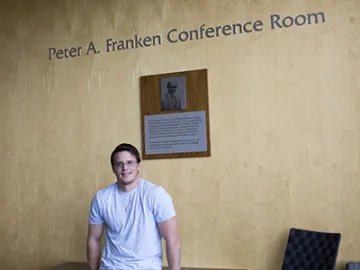Another Wavelength: Edward LaVilla

For this month's Another Wavelength feature, we're talking to second-year optical engineering Ph.D. student Eddie LaVilla, who hails from Rochester, New York. He received his bachelor's degree in physics from the University of New Hampshire in 2013.
What brought you to optics?
I was home working with my father, who is a painter, in between junior and senior year of college. He took me along when he went to quote a job for two optics professors from the U of R. I spent some time talking with them and learning about what optics really was. It seemed to have the practical nature of physics that I was looking for.

Who would you call your science hero?
My hero in science is probably Leonard Susskind. He was one of the original forces behind string theory, and after seeing a BBC documentary on the subject when I was about 15, I was hooked on physics. The reason I would call him my hero, and not Einstein, is very subtle. First, I don't know where I would have ended up if I hadn't seen that string theory documentary. Also, it was his explanation of the subject. He took some of the most challenging math and physics concepts ever developed, and explained them to an audience with zero background in a way that gave insight and created curiosity. I think those who have this ability of bringing science and knowledge to a level for everyone to enjoy and comprehend are truly special.
Describe your research in 20 words or fewer.
Wavefront sensing using geometrical optics and freeform fabrication and metrology.
Describe your research in 200 words or fewer.
I'm working on three projects with Jim Schwiegerling. One is 3-D image reconstruction using a 2-D photo of an object illuminated by a rainbow pattern. The system used triangulation to calculate the topography of the object.

A second project is an automated moire deflectometry system. Basically a wavefront can be characterized in both reflection or transmission through a moire pattern using Fourier transform techniques and phase mapping. In layman's terms, if we had an apple (object) and it had some defects like bumps or holes that we didn't know about (object wavefront), then imaging the apple through the moire pattern would shows bends in the pattern. These bends correspond to the deflections (in x and y) of the apple surface (object wavefront) and allows us to recreate the surface of the apple.
Lastly, I have been working with the diamond turning machine downstairs on an array of freeform optics. We would also like to characterize some cutting routines for different lens materials in the future.
Name three neat facts about you.
- I've collected the tickets for every concert and major sporting event I've ever attended.
- I've ice skated across the city of Ottawa through both Ontario and Quebec.
- I survived after-hours at an Irish pub in NYC.
